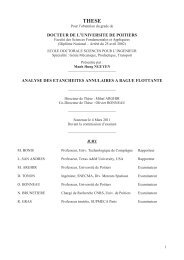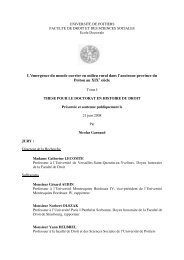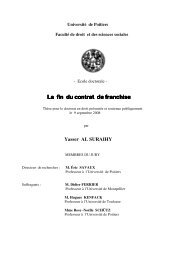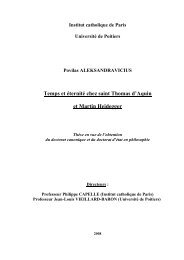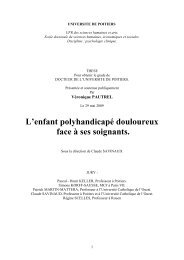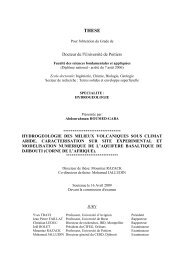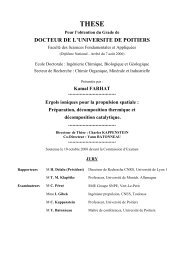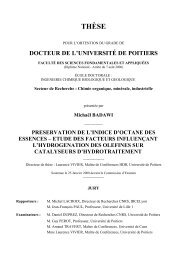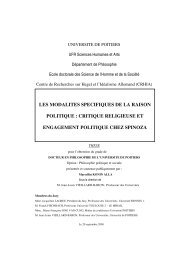Etude et développement d'un actionneur plasma à décharge à ...
Etude et développement d'un actionneur plasma à décharge à ...
Etude et développement d'un actionneur plasma à décharge à ...
You also want an ePaper? Increase the reach of your titles
YUMPU automatically turns print PDFs into web optimized ePapers that Google loves.
Annexes<br />
E. Control Process Scenario<br />
The observation of the lift enhancement when the flow over an airfoil is forced by an <strong>plasma</strong> actuation is not<br />
new. However, most of the studies are based on force measurements, proposing a global estimation of the<br />
effectiveness of <strong>plasma</strong> actuators. No study has investigated flow reattachment process and only predictive<br />
comments are usually introduced in the published researches. In the present study the rep<strong>et</strong>ition rate of the PIV<br />
system is high enough to measure time-resolved PIV vectors fields and thus the control process can be<br />
investigated. All the acquisitions (quasi-steady and unsteady cases) were carefully observed and it appears that a<br />
repeatable process seems to be responsible of the partial flow reattachment reported in the present study. To<br />
illustrate the temporal evolution of the reattachment, the instantaneous vectors of velocity are plotted in figure 20<br />
for time varying from the beginning of the actuation up to 30 ms. Through the analysis of different flow<br />
sequence, it appears that the local tangential electric wind induced by the BDD actuator is too low to create a<br />
discr<strong>et</strong>e vortex above the leading edge. The instantaneous velocity fields reveal that the actuation can promote<br />
the coalescence of two successive discr<strong>et</strong>e large scale structures as illustrated in figure 20 at t=0 and 3.3 ms<br />
(Vort-1 and 2 in figure 20). The merging of vortices (Vort-1 and Vort-2) produces an energized large flow<br />
structure (Vort-3 in figure 20). The size and the strength of this vortex is enhanced by the external airflow and<br />
results in a momentum transfer from the outer flow to the boundary layer of the upside surface of the airfoil. This<br />
vortex should modify the pressure gradient along the suction side and it results in a flow topology presenting a<br />
front (velocity with a primary velocity component largely lower than the second one), perpendicular to the airfoil<br />
chord and moving toward the trailing edge (see t=6.66, 10 and 13.3 ms in figure 20). The separation point at the<br />
leading edge is not modified, the shear layer is still separated from the suction side and the vortex shedding at the<br />
leading edge is still present. But, the vortex issuing from the separation point (vort-4 in figure 20) is not<br />
convected along the shear layer axis due to the front of velocity which leads to a local pressure decrease and acts<br />
like a virtual obstacle. The trajectory of this second vortex is moved along the suction side with a sense of<br />
rotation promoting a momentum transfer to the boundary layer region. When the vortex “vort-3” is in the wake<br />
of the airfoil, the mutual interaction b<strong>et</strong>ween vort-3 and vort-4 disappears (time t=23.33 ms in figure 20). At this<br />
time the flow is reattached over 70% of the chord length and remains attached despite the natural instabilities<br />
occurring in the boundary layer and resulting in a vortex shedding at the trailing edge.<br />
Finally, it appears that the reattachment process results from interacting vortices energized by the electric<br />
wind because the actuation by DBD is not strong enough to produce vortices or streamwise vorticity by itself,<br />
contrary to synth<strong>et</strong>ic j<strong>et</strong>s for instance. The <strong>plasma</strong> discharge acts as a catalyser for the flow reattachment and<br />
requires to interact with natural flow structures. This point is essential and may explain the reason of the<br />
improvement of the control authority when an unsteady actuation is applied as reported by other. But in this<br />
case, the unsteady actuation requires to be synchronized with the natural vortex shedding to be operational in the<br />
first milliseconds following the actuation. When the actuator is driven at a low frequency, the statistical<br />
probability to act at the right time is decreased and could explain the lack of authority of the actuation at F + =0.5.<br />
Moreover, the duty-cycle requires to be high enough to promote the vortex merging necessary to initiate the flow<br />
reattachment. One can notice that one can not be sure that a similar process would be observed if the natural flow<br />
was fully turbulent. However, it has been verified that the flow remains fully d<strong>et</strong>ached when the laminar-toturbulent<br />
transition is obtained by a tripper placed at the leading edge. This demonstrates that the flow<br />
reattachment is not due to laminar-to-turbulent transition.<br />
- 193 -



